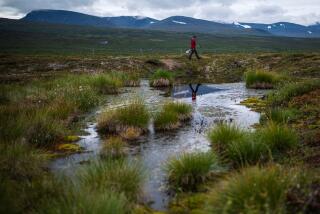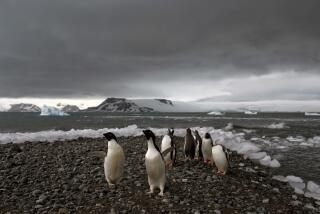Mysteries of Sea Ice in Arctic Frustrate Scientists
- Share via
The sea ice that waxes and wanes with the seasons at the poles has long been seen as a window into the Earth’s complex climate system. Any global changes are likely to be most visible--and extreme--on the frozen edges of the Earth that are most vulnerable to warming.
But that ice has long frustrated legions of scientists trying to capture its vagaries. Icebreakers moving through the region and taking measurements are rare, and nonexistent in the winter when the pack ice freezes tight.
Submarines that once traversed the pole and measured ice thickness from below have largely been decommissioned since the end of the Cold War. And satellites have long been stymied by thick, white Arctic clouds that look, from space, so much like the ice itself.
But a powerful new satellite is giving scientists at the Jet Propulsion Laboratory their first close-up view of the tortured surface of the Arctic Ocean. And the initial images released this week are already causing a stir: They confirm scientists’ notions that while warming appears to be affecting the entire Arctic region, cracks exposing water at the North Pole are not a clear-cut result of global warming.
The satellite sees through clouds and the long polar night, takes images with a resolution of less than an inch, and allows scientists to view sequential images of the ice like time-lapse films.
“It gives you a picture of how the ice cover is moving about,” said Drew Rothrock, a sea ice researcher at the University of Washington’s Applied Physics Laboratory. “It’s amazing what you can figure out looking down from space.”
What do they see? Cracks. Lots and lots of cracks. Some more than 1,200 miles long and most several miles wide. “They go from one part of the Arctic to another,” said Ron Kwok, who heads the polar remote sensing group at JPL. “There are thousands of them all over the place.”
Though dramatic and longer than previously believed, the cracks are not clear evidence that global warming is occurring, he said. Scientists have long known that such cracks fracture the Arctic ice, a skin that ranges from a few inches to 10 feet in thickness.
Knowledge of the cracks has many oceanographers this week pooh-poohing recent eyewitness reports of open water at the North Pole. The reports gained widespread media attention and were presented as evidence that the effects of global warming are now extensive.
Passengers on a tour ship returning from the North Pole last week reported a mile-wide patch of open ocean at the very top of the Earth. The open water prevented the tourists from having their pictures snapped at the geographic North Pole, and astonished the veteran Russian captain piloting the icebreaker carrying the tourists.
But scientists who have been studying North Pole ice and its vagaries for decades found nothing astonishing in the report.
“There are mile-wide cracks all over the Arctic in the summer,” said Rothrock.
JPL’s Kwok said there is “nothing special” about cracks at the North Pole, because they can occur anywhere within the Arctic ice. Members of his group had not seen current satellite images of an opening at the pole this summer because they had not yet processed recent images. They hope to check the new images in coming weeks.
Kwok’s team will continue monitoring changes in the sea ice, particularly patterns of cracks, to look for evidence of global warming. He hopes the time-lapse images of ice forming will allow his team, for the first time, to estimate ice thickness from space. Although the polar oceans may seem static, they are actually violent places with ice shifting, groaning, breaking and piling up on a daily basis.
“If there are any changes in the global climate, it’s going to be reflected in the sea ice--at the poles,” he said. In turn, those changes in sea ice greatly alter climate.
Open areas within the ice, or polynyas, allow the ocean’s heat to escape into the atmosphere. They also mean that less solar radiation is reflected away from Earth.
Though the new images are not proof of any change, Arctic temperatures have been rising steadily. A review of 40 years of polar research published last month shows that temperatures in some parts of the Arctic have risen by 11 degrees in the past 30 years. In addition, snow and sea ice cover have dropped and many glaciers have shrunk.
In contrast to the cracks, this overall warming and shrinking is thought to have its roots in global warming.
The Shrinking Arctic Sea Ice
“There’s a fairly wide body of evidence there is change occurring,” said Mark Serreze, a polar scientist at the University of Colorado’s National Snow and Ice Data Center who led the review. The Arctic Ocean has also warmed thousands of feet below the surface, he said.
Arctic sea ice covers about 9 million square miles in early spring and 5 million square miles in early fall. The sea ice cover has shrunk by more than 6% since 1978, according to satellite images. Sea ice is generally about 10 feet thick, though that can be highly variable due to wind and weather conditions.
The thickness of sea ice appears to have been cut nearly in half over the last four decades, according to sonar data from Cold War submarines recently analyzed by Rothrock. His findings showed that ice thickness had decreased on average from 10.2 feet in the 1960s to 5.9 feet in the 1990s.
The motion of sea ice and the opening and closing of cracks may play a large role in regulating temperatures around the globe. The North Pole acts as a heat sink: It stays cold because it is dark for much of the year and because snow and ice there reflect warming sunlight back into space.
Less ice cover means more warmth for the poles--and eventually for the entire Earth. More recently, scientists have discovered that sea ice changes affect the circulation of ocean waters and the Gulf Stream, changes that could alter temperatures far from the poles.
The main question, still unresolved, is whether warming seen in the Arctic and elsewhere is prompted by human or natural causes. The answers from these remote and inhospitable regions will still be difficult to find.
Even the current satellite technology, for example, has trouble distinguishing melting spring sea ice from water--a problem that can make readings of spring and summer ice less reliable than those of winter ice. The shifting pictures are also complicated by winds and storms that affect the ice pack. Another mystery: While ice cover has decreased at the North Pole, it has increased around Antarctica.
“Today, with all our capability and technology, we really don’t know that much about Arctic sea ice,” said Serreze.
In the meantime, he said, observations such as the one made by tourists at the North Pole are interesting, but not much more than that.
“An observation has to be taken in context,” said Serreze. “The point is, we don’t have the context.”
*
McFarling can be reached at usha.mcfarling@latimes.com
(BEGIN TEXT OF INFOBOX / INFOGRAPHIC)
Breaking the Ice
Studying Arctic sea ice is a crucial part of efforts to understand the Earth’s climate and determine the effects of global warming. But studying the shifting ice, which changes daily and seasonally, has been a challenge. New satellite tools developed at JPL may change that.
*
Sources: JPL/NASA ; Univ. of Colorado/ National Snow and Ice Data Center; Univ. of Washington






